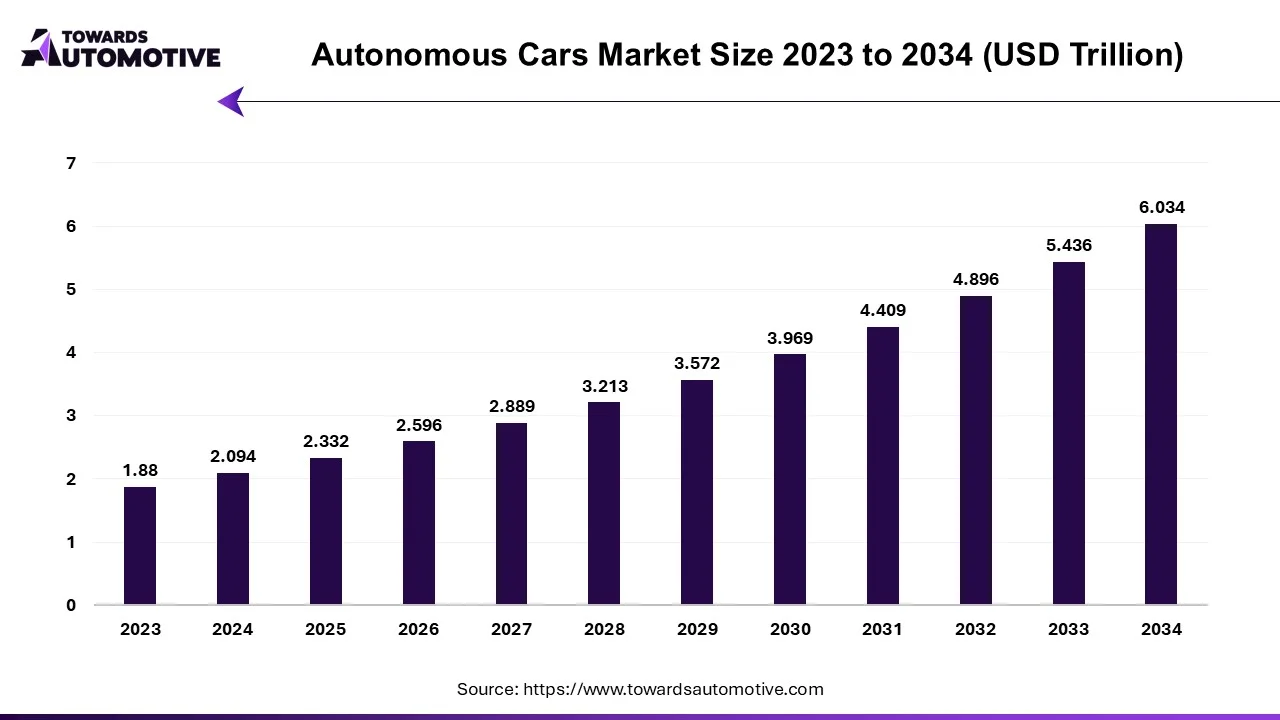Artificial Intelligence (AI) is the driving force behind the revolutionary advancements in the autonomous cars market, transforming the way vehicles navigate and operate on the road. As the cornerstone of autonomous driving technology, AI empowers self-driving vehicles to make informed decisions, interpret their surroundings, and perform tasks without the need for human intervention. The global autonomous cars market is already witnessing tremendous growth, with its size calculated at USD 2.094 trillion in 2024. It is expected to be worth USD 6.034 trillion by 2034, expanding at a compound annual growth rate (CAGR) of 11.39% from 2024 to 2034, illustrating the significant impact AI will continue to have on the industry.

Get All the Details in Our Solution – Download Brochure @ https://www.towardsautomotive.com/download-brochure/1273
AI’s Core Functions in Autonomous Vehicles
AI plays a critical role in processing the massive volumes of data generated by a vehicle’s sensors, cameras, LiDAR, and radar systems. These devices continuously monitor the vehicle’s environment, providing essential information for the car to make real-time decisions. Machine learning (ML) and deep learning algorithms process this data, enabling the vehicle to recognize objects, understand the road layout, and predict the behavior of other road users, such as pedestrians and other vehicles. This capability is crucial for autonomous cars to make informed decisions and navigate safely.
Computer Vision and Sensor Fusion
Among AI’s most vital applications in autonomous cars is computer vision. This technology enables vehicles to interpret visual data from cameras, allowing them to perform tasks such as detecting road signs, identifying pedestrians, analyzing traffic patterns, and observing lane markings. Computer vision ensures that autonomous vehicles can follow traffic regulations and navigate streets accurately, even in complex environments.
Moreover, AI-driven sensor fusion combines data from multiple sources, such as cameras, radar, and LiDAR, to build a comprehensive 3D model of the car’s surroundings. This approach enhances the vehicle’s ability to understand its environment, ensuring it can safely navigate through diverse conditions, including inclement weather or high-density urban areas where traditional driving can be challenging.
Predictive Analytics for Safety and Efficiency
AI also facilitates predictive analytics in autonomous vehicles. By analyzing data in real-time, AI allows vehicles to anticipate potential hazards, such as sudden obstacles or changing road conditions. These systems continuously learn from past experiences, helping autonomous cars improve their decision-making processes. Predictive capabilities are key to avoiding accidents, optimizing route planning, and ensuring overall safety on the road.
In addition to enhancing safety, AI aids in optimizing efficiency. Autonomous vehicles powered by AI can analyze traffic patterns, weather conditions, and road closures to determine the most efficient routes, reducing travel time, fuel consumption, and emissions. This level of optimization contributes to the sustainability and cost-effectiveness of self-driving vehicles.
Vehicle-to-Everything (V2X) Communication
Another essential application of AI in autonomous vehicles is Vehicle-to-Everything (V2X) communication. This technology enables autonomous cars to communicate seamlessly with other vehicles, infrastructure, and connected devices. V2X communication allows for synchronized traffic flow, improved safety, and more efficient transportation systems by enabling real-time data exchange between autonomous cars and their surrounding environment.
Advancements in Simulation and Fleet Management
AI also supports the autonomous vehicle ecosystem through advancements in simulation technologies. Testing and training self-driving algorithms using AI-powered simulations help ensure that vehicles perform optimally under various driving conditions before being deployed on the road. AI-driven simulations reduce the need for extensive on-road testing, speeding up the development and rollout of autonomous cars.
Furthermore, AI plays a vital role in optimizing fleet management for mobility-as-a-service (MaaS) platforms. By using AI to optimize routing, scheduling, maintenance, and energy consumption, MaaS providers can maximize the operational efficiency of autonomous vehicle fleets, ensuring that self-driving cars are used effectively and efficiently in shared transportation services.
Panasonic’s Cirrus 2.0: Enhancing V2X Capabilities
A notable example of AI’s impact on the autonomous vehicle sector is Panasonic’s launch of Cirrus 2.0 in April 2024. Cirrus 2.0 is a cutting-edge vehicle-to-everything (V2X) ecosystem that enhances the capabilities of autonomous vehicle commercial fleet operators. This ecosystem facilitates real-time communication between vehicles and infrastructure, further advancing the integration of AI in autonomous driving systems and improving the overall functionality of self-driving fleets.
Invest in Our Premium Strategic Solution @ https://www.towardsautomotive.com/price/1273
You can place an order or ask any questions, please feel free to contact us at sales@towardsautomotive.com
Explore the comprehensive statistics and insights on automotive industry data and its associated segmentation: Get a Subscription
For Latest Update Follow Us: https://www.linkedin.com/company/towards-automotive
